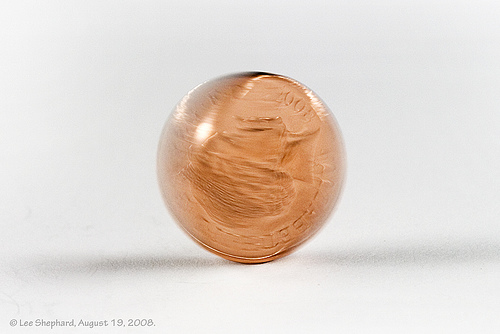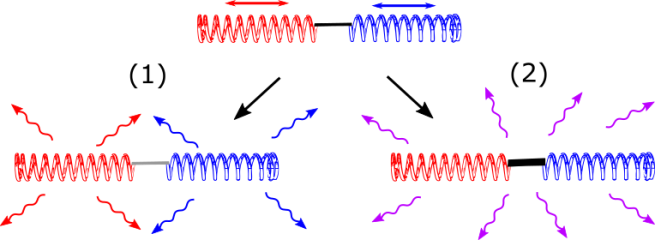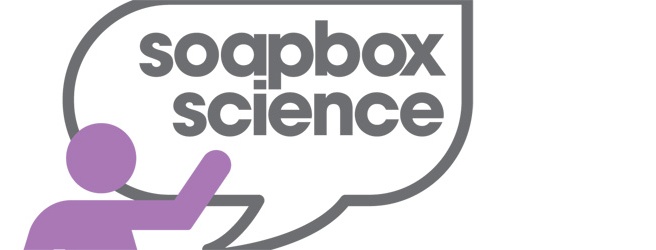Recently we had some good news – our paper has been published in Physical Review A (open access version here). So I’m going to digress from the usual format of this blog and explain our research for the non-technical reader. Enjoy!
Quantum physics, the description of our Universe on very small scales, has been around for about a century now, and it has some astonishing predictions. Particles can ‘tunnel’ through walls and an electron can even travel through two slits simultaneously and then interact with itself. What’s more astonishing is that the predictions made by quantum mechanics have been verified in thousands of experiments, confirming that our Universe is, well, odd.
Quantum revolutions
We’ve been using the quantum properties of matter to our advantage for decades now. Quantum mechanics allows us to describe the structure of the atom, the periodic table, semiconductors and much more. The advances in quantum theory that were made at the beginning of the twentieth century have been dubbed the “first quantum revolution”. The subsequent progress in semiconductor physics has led to the technological revolution we’re seeing today, in which computers more powerful than the one that first sent humans to the moon now sit inside your toaster.
The advances brought about by the first quantum revolution came from understanding how large groups of electrons behaved inside different materials. Then materials with the desired properties could be made, for example by doping semiconductors in order to build complex structures like LEDs.
Now, we’re starting to understand how to exploit other quantum phenomena, such as superposition, in what one might call the second quantum revolution. Superposition lies at the heart of many proposed quantum technologies, such as quantum computing, quantum sensors, quantum cryptography and more. Superposition is also a profoundly quantum property, with no classical (“everyday”) equivalent, so what follows is an analogue.
Superposition and coherence
Suppose you have a coin, and you flip it. There’s 50% chance that it will show heads; 50% tails. We don’t know which it will be on any given flip, but we know it will be one or the other. That’s a “classical” coin. Now suppose you take your coin and set it spinning on the table. That coin isn’t showing either heads or tails; in some way it is partly in both states at the same time. In our analogy, our “quantum” coin is now in a superposition of heads and tails. Unlike our classical coin, it has coherence.

Coins (even quantum ones) don’t spin forever, and sooner or later our coin will stop spinning, due to friction, to air resistance, or due someone knocking the table. In other words, the rest of the world interacts with our coin and disrupts it. How quickly this happens depends on the exact conditions of the surrounding environment, but it will always happen sooner or later. When our coin stops, it falls over onto one side, and becomes like a classical coin again. We say that it has decohered.
Decoherence is a big problem when building a quantum computer – quantum computers rely on keeping many particles in a superposition and using them to do calculations. But these particles quickly decohere, losing their quantum information. Understanding and working out how to control decoherence is a big priority for quantum physics research today.
A pair of tiny quantum springs
We already have maths that describes what happens when one single quantum particle interacts with its surroundings and loses coherence; however things get trickier when there are two (or more!) particles in the mix. The type of particles we were looking at in our paper are called bosons, and they can be thought of as being like very tiny springs. Imagine that our two tiny springs are joined together by a rod, so that as one bounces back and forth, it affects the motion of the other, and vice versa.

Our question was: how does joining the two springs together affect their decoherence? There were two possible approaches:
- The springs would behave as though they weren’t joined, and each one would decohere at its own rate, regardless of what was happening to the other one.
- The springs would act like a single mega-spring, and this mega-spring would decohere all at the same rate.
Approach #1 works well when the two springs are only loosely joined (e.g. by a slack piece of string). Approach #2 is great when our two springs are joined tightly by a rigid rod, so that one cannot move without greatly affecting the other one. But what do we do when the joining falls somewhere between these two extreme cases? We found a method of dealing with intermediate cases in a consistent way which takes account of both the joining between the springs and the differing rates at which the two springs decohere.
What next?
The work in our paper uses particles called bosons, but there’s another type of particle in town: the fermion. In fact, everything is made up of bosons and fermions. Examples of bosons include photons (particles of light) and particles such as gluons and the Higgs , most familiar to particle physicists. Fermions make up the matter around us, such as electrons and quarks (these form protons and neutrons which in turn form atomic nuclei).
Now that we understand how a pair of bosons decohere, there are two avenues of research open to us. Firstly, we can use our method and extend it to look at a larger collection of bosons, and understand their decoherence. The second is to use similar techniques to derive a method for dealing with two fermions which are joined together. It’s this second question that has been preoccupying me, and we’re close to getting some exciting results on that one, so sit tight and hopefully there’ll be more news on that question soon.







